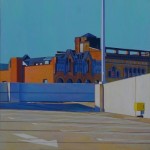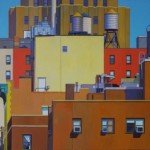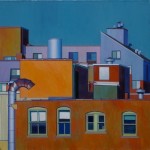How did you become interested in your subject matter?
I lived in New York City for 22 years. While in New York, I would often go over to the East River to take photographs of the Queens/Brooklyn skyline. There was one area that intrigued me – lots of old, falling down buildings and warehouses – and I wanted to do a large painting of it but just didn’t have the studio space. Later, when I had the space I was able to do that painting. It still hangs in my home. It triggered my passion for cityscapes.
Do you paint other cities besides New York?
Yes, I take my camera with me whenever I visit a city – although I do find that New York continues to provide the most inspiration, along with Baltimore – something to do with the urban character of these two cities. Pittsburgh and Boston have a similar feel to me. I’m not trying to “document” specific cities or buildings (unless it is a commission) so it isn’t that important to me what city I’m painting.
How do you get inspired?
Looking at artwork in museums, galleries or art fairs inspires me. I always enjoy seeing other urban landscapes. Walking through cities inspires me too.
What time of day do you like to be in the studio?
I’m usually in the studio all day, starting at about nine in morning. I’ll break for dinner and go back to work until about 7 or 8 o’clock. If I’m not painting, I’m building frames, or taking photographs – something related to my artwork.
Do you paint on location?
No, I work from photographs that I’ve taken. I must have thousands of images by now.
How did your color palette evolve?
When I first started painting cityscapes I stuck with the colors I saw. It took me a couple of years to start playing with color and exaggerate the palette. In 2007, I began experimenting with paper collage, which allowed me to “flatten” the colors, which in turn influenced my painting and color choice. I’m surprised when I look back at how much my palette has changed – it’s more vibrant and creative now.
Who collects your work?
All kinds of people. Often, I find that people working in some aspect of design or building are particularly drawn to my work – architects, interior designers, real estate developers, etc. People who live in cities also seem to appreciate my work.
How is your depiction of the urban landscape unique?
Unlike many artists, I eliminate all people, vehicles, vegetation, graffiti, etc. I move, delete, or add architectural features in order to focus on the composition. Buildings – along with the windows, doorways, and other elements – are really just shapes and for me, a painting is about arranging those shapes in an interesting way.
What are your favorite art museums in New York or around the world?
I like going to museums where ever I am. I enjoy New York’s “usual suspects” – the Met, the Modern, Whitney, the Guggenheim. Recently, I went to the New Museum, which was great. In DC, The National Portrait Gallery, the American Art Museum, the Phillips and the Corcoran. I also visit the museums in Baltimore, including the Visionary Art Museum.
Who are some of your favorite artists?
Two of my favorites have always been Chuck Close and Lucian Freud. I love how they manipulate their subject matter to create really interesting work. This is what I’m trying to accomplish in my own work. Charles Sheeler is an artist that I’ve become intrigued with as a result of urban landscapes. His abstract cityscapes are really exciting and the fact that he was a photographer is really interesting to me. My uncle, Don Aquilino, is one of my favorite artists. He has been a fulltime artist all his life, working in both painting and sculpture. In addition to being an inspiration, he has been a teacher. At 80 years old, he is still in the studio painting.
In a city like New York with a million vistas, what’s your favorite vantage point?
I prefer looking across at buildings rather than up from the street. The challenge is finding that vantage point. I take lots of photographs from the tops of parking garages, from bridges or overpasses, and through windows of other buildings.
What’s hanging on the walls in your home?
My work, which rotates as pieces get moved out for shows. Other pieces include paintings and drawings by my uncle Don. There is also a growing collection of artwork by Washington, DC area artists. Some are purchased and others are trades. Whenever possible, my wife and I try to buy artwork when a painting sells. We think it is important to support other artists.
What would our readers be surprised to know about your work?
I think people would be surprised to know how fast I work. I was a commercial artist for 25 years, both as a conventional illustrator and then as a digital artist doing 2D and 3D animation. I always worked under pressure and deadlines – there wasn’t time to spend three months on a painting getting it just right. I think that’s why I spend long days in the studio, often working on two or three paintings at a time.
–






John does great work. We’ve shown together in New York a few times over that past few years at the Affordable Art Fair and I always dig his stuff.